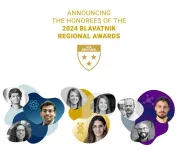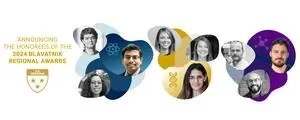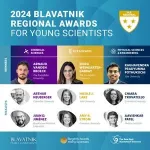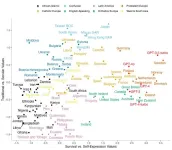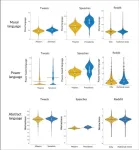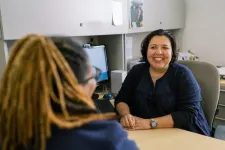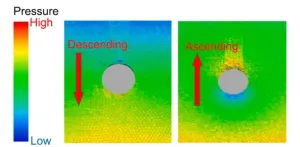(Press-News.org) NEW YORK – September 17, 2024 – The Blavatnik Family Foundation and The New York Academy of Sciences today announced the three Laureates and six Finalists of the 2024 Blavatnik Regional Awards for Young Scientists. The Awards honor outstanding postdoctoral scientists from academic research institutions across New York, New Jersey, and Connecticut.
The Blavatnik Regional Awards jury, consisting of distinguished scientists and engineers, selected one Laureate in each category who will receive a $30,000 unrestricted prize and two Finalists in each category who will be awarded $10,000 each. The three Laureates and six Finalists were chosen out of 134 highly competitive nominations received from 24 academic institutions in the Tri-State area.
The announcement comes during the National Postdoctoral Association’s 15th annual celebration of 2024 National Postdoc Appreciation Week, which recognizes the significant contributions that postdoctoral scholars make to U.S. research and discovery.
The 2024 Blavatnik Regional Awards Winners and Finalists will be honored at the 2024 Blavatnik Awards for Young Scientists Ceremony at the American Museum of Natural History, Central Park West and 79th Street, on October 1, 2024.
“It is a great pleasure to congratulate and honor our outstanding Laureates and Finalists,” said Len Blavatnik, Founder of Access Industries and the Blavatnik Family Foundation, and member of the President’s Council of The New York Academy of Sciences. “Their ongoing research and discoveries will contribute to the global scientific community for years to come.”
“Postdocs help drive research and innovation forward and are catalysts for new scientific ideas and applied technologies,” said Nicholas B. Dirks, President and CEO of The New York Academy of Sciences. “We are incredibly proud to announce these outstanding postdoctoral honorees of the 2024 Blavatnik Regional Awards, especially during National Postdoc Appreciation Week — a week dedicated to recognizing the important contributions that postdoctoral scholars make to American research and discovery.”
The 2024 Blavatnik Regional Awards Winners in the three award categories are:
Chemical Sciences: Arnaud Vanden-Broeck, Ph.D., nominated by The Rockefeller University
Biochemist and structural biologist Arnaud Vanden-Broeck is leading groundbreaking work in uncovering the intricate processes behind human ribosome assembly, laying the foundation for treating cancers and diseases related to ribosome dysfunction.
Physical Sciences & Engineering: Raghavendra Pradyumna Pothukuchi, Ph.D., nominated by Yale University
The work of computer scientist Raghavendra Pradyumna Pothukuchi has led to unprecedented advances in creating a “brain-memex”, a system that interfaces computers with the human brain and could fundamentally shift our ability to understand neurological characteristics.
Life Sciences: Shira Weingarten-Gabbay, Ph.D., nominated by The Rockefeller University
Through her research, virologist Shira Weingarten-Gabbay has uncovered thousands of novel microproteins encoded in the “dark matter” of viral genomes, which has exposed previously unknown immune targets for vaccines.
The following postdoctoral researchers have been named Finalists in their respective categories:
Chemical Sciences
Juan D. Jiménez, Ph.D., nominated by Brookhaven National Laboratory
Chemical engineer Juan D. Jiménez is advancing sustainable industrial practices by developing novel catalytic materials that transform greenhouse gases like CO2 and methane into valuable chemical products.
Arthur Neuberger, Ph.D., nominated by Columbia University
As a Professor of Molecular Bioimaging at LMU Munich, Arthur Neuberger conducts pioneering research on TRP channels, which has led to new ways of treating pain, cancer, and skin diseases, as well as deciphering the mechanism of how we sense temperature.
Physical Sciences & Engineering
Aavishkar Patel, Ph.D., nominated by the Flatiron Institute
Condensed matter theorist Aavishkar Patel is advancing a new theoretical understanding of “strange metals” and their tendencies towards superconductivity based on how microscopic irregularities in materials modify electron interactions.
Chiara Trovatello, Ph.D., nominated by Columbia University
Nanotechnology materials scientist Chiara Trovatello is developing new nano-engineered material platforms for optical computing, a critical step towards innovative imaging and information processing methods in quantum technologies.
Life Sciences
Nicole J. Lake, Ph.D., nominated by Yale University
Geneticist Nicole J. Lake is developing novel tools to study genetic variation in mitochondrial DNA (mtDNA) to improve genetic diagnostics for patients with rare diseases.
Amy R. Strom, Ph.D., nominated by Princeton University
Molecular and cellular biologist Amy R. Storm is exploring the organization of biological “condensates” that physically compartmentalize target genes in the cell, influencing the expression of cancer-causing genes.
About the Blavatnik Awards for Young Scientists
The Blavatnik Awards for Young Scientists, established by the Blavatnik Family Foundation in 2007 and independently administered by The New York Academy of Sciences, initially identified outstanding regional scientific talent among faculty and postdoctoral students in New York, New Jersey, and Connecticut. The Blavatnik National Awards, honoring faculty-rank scientists throughout the United States, were first awarded in 2014 and were expanded in 2017 to honor faculty-rank scientists in the United Kingdom and Israel. By the end of 2024, the Blavatnik Awards will have awarded prizes totaling $17.4 million and, to date, has honored over 570 scientists.
Blavatnik Awards scholars are driving economic growth by embarking on new scientific trajectories to pursue high-risk, high-reward scientific research. To date, Blavatnik Awards honorees have founded 74 companies. After recognition by the Blavatnik Awards, 30% of past honorees obtained a patent or filed a patent application, 75% have started a new research direction, and 11% have started a new collaboration with another Blavatnik Awards honoree. Visit blavatnikawards.org for further information.
About the Blavatnik Family Foundation
The Blavatnik Family Foundation provides many of the world’s best researchers, scientists and future leaders with the support and funding needed to solve humankind’s greatest challenges. Led by Len Blavatnik, founder of Access Industries, the Foundation advances and promotes innovation, discovery and creativity to benefit the whole of society. Over the past decade, the Foundation has contributed over US$1 billion to more than 250 organizations. See more at www.blavatnikfoundation.org.
About The New York Academy of Sciences
The New York Academy of Sciences is an independent, not-for-profit organization that, since 1817, has been committed to advancing science for the benefit of society. With more than 20,000 members in 100 countries, the Academy advances scientific and technical knowledge, addresses global challenges with science-based solutions, and sponsors a wide variety of educational initiatives at all levels for STEM and STEM-related fields. The Academy hosts programs and publishes content in the areas of life and physical sciences, the social sciences, nutrition, artificial intelligence, computer science, and sustainability. The Academy also provides professional and educational resources for researchers across all phases of their careers. The Blavatnik Awards for Young Scientists is part of a series of prominent awards and scholarship programs that the Academy and its partners present each year to accomplished early-career and established scientists worldwide. These initiatives, along with education and professional development programs for students and young scientists, reflect the Academy’s broader commitment to strengthening and diversifying the pipeline for skilled and talented scientists globally. Please visit us online at www.nyas.org.
END
Nine outstanding postdoctoral scholars for the 2024 Blavatnik Regional Awards for Young Scientists announced
Cutting-edge research includes the study of the human ribosome to combat cancer, interfacing machines with the human brain to better understand neurological characteristics, and decoding the “dark matter” of viral genomes to mitigate viral threats.
2024-09-17
ELSE PRESS RELEASES FROM THIS DATE:
People underestimate the income of the top 1%
2024-09-17
People selectively underestimate how rich the world’s richest people are, according to a study. Increasing income inequality in many countries is driven by steep gains among the top 1% of earners. In the United States, support for policies that would redistribute wealth has not increased since the 1970s, even as the share of incomes held by the top 1% of Americans jumped from 10% to 19%. Barnabas Szaszi and colleagues conducted four studies to explore how well people understand the wealth held by others. In one study, 990 US residents ...
ChatGPT and cultural bias
2024-09-17
A study finds that ChatGPT expresses cultural values resembling people in English-speaking and Protestant European countries. Large language models, including ChatGPT, are trained on data that overrepresent certain countries and cultures, raising the possibility that the output from these models may be culturally biased. René F Kizilcec and colleagues asked five different versions of OpenAI’s GPT to answer 10 questions drawn from the World Values Survey, an established measure of cultural values used for decades to collect data from countries around the world. The ten questions place respondents ...
National political dialogue focused on power and morals
2024-09-17
A study of political speeches, social media posts from politicians, and Reddit discussions among everyday users finds a higher prevalence of abstract, moralized, and power-centric language in national versus local politics. Political dialogue and debate in the United States has largely shifted from the local to the national in recent years, in part due to the decline of local news media. However, national discussions lack the concrete common ground that comes from shared place-based knowledge. Danica Dillion and colleagues studied how this shift is affecting ...
Police body-camera footage as data
2024-09-17
A study uses body-worn camera footage as a source of data on police-community interactions. Nicholas Camp and colleagues analyzed transcripts from 615 police stops made in California by Oakland Police Department police officers before and after a procedural justice training, which focused on officer communication in routine traffic stops. The training included findings by the authors in a previous study that showed officers used more respectful language with White drivers than with Black drivers during traffic stops. The training ...
Intimate partner violence: Preserving patient privacy saves lives
2024-09-17
Historically, South Carolina has had some of the highest rates of intimate partner violence, or IPV, in the U.S. IPV encompasses any physical or sexual violence, stalking and psychological aggression by a current or previous partner or spouse.
“There is an epidemic of intimate partner violence in South Carolina,” said Leslie A. Lenert, M.D., associate provost of Data Science and Informatics and director of the Biomedical Informatics Center at the Medical University of South Carolina.
To address that epidemic, Lenert partnered with clinical psychologist Alyssa A. Rheingold, Ph.D., family physician Vanessa Diaz, M.D., and health services ...
Moving particle simulation-aided soil plasticity analysis for earth pressure balance shield tunnelling
2024-09-17
Infrastructures often suffer severe damage due to geotechnical hazards of both natural kinds such as floods or earthquakes and man-made ones like underground construction work and excavations. The fields of civil engineering and disaster risk management have extensively studied methods to prevent these risks and are still looking for more effective ways of avoiding large-scale deformations associated with said hazards. The advent of computer-aided simulations has provided researchers with particle-based methods such as moving particle ...
Identifying body-scan postures suitable for people with hyperactivity tendency
2024-09-17
ADHD is a developmental condition of brain with symptoms such as inattention, hyperactivity or impulsivity. People with ADHD lack the ability of self-control and experience anxiety, depression, academic failure, and low self-confidence. These symptoms can be alleviated by a holistic approach such as mindfulness-based stress reduction and mindfulness-based cognitive therapy. These practices encourage patients to pay attention to the present moment with purpose and without judgment. However, these practices involving meditation require sitting in certain postures which can be challenging for patients with high ADHD tendency.
To address this, ...
Indiana University selects Symplectic Elements as faculty activity reporting system
2024-09-17
Digital Science, a technology company serving stakeholders across the research ecosystem, is pleased to announce that Indiana University has selected Symplectic Elements as its new faculty activity management and reporting system.
This strategic decision marks a significant advancement toward the university’s goals of streamlining the management and reporting of the work and accomplishments of its faculty.
Indiana University is internationally known for outstanding research and its world-class degree programs, from business and health to STEM and the arts at its flagship campus in Bloomington, the expanding ...
Stephenson Prize for Innovation in Pancreatic Cancer Research launched with $150 million gift to City of Hope
2024-09-17
LOS ANGELES — City of Hope®, one of the largest and most advanced cancer research and treatment organizations in the U.S. and ranked among the nation’s top 5 cancer centers by U.S. News & World Report, has received a historic $150 million gift from entrepreneurs and philanthropists A. Emmet Stephenson Jr. and his daughter Tessa Stephenson Brand to immediately fund pancreatic cancer research.
The centerpiece of this gift is the $1 million Stephenson Prize, one of the largest ...
New understanding of the limits on nano-noise
2024-09-17
Thanks to nanoscale devices as small as human cells, researchers can create groundbreaking material properties, leading to smaller, faster, and more energy-efficient electronics. However, to fully unlock the potential of nanotechnology, addressing noise is crucial. A research team at Chalmers University of Technology, in Sweden, has taken a significant step toward unraveling fundamental constraints on noise, paving the way for future nanoelectronics.
Nanotechnology is rapidly advancing, capturing ...
LAST 30 PRESS RELEASES:
Manta rays create mobile ecosystems, study finds
Study: Mixed results in using lipoic acid to treat progressive multiple sclerosis
Norbert Holtkamp appointed director of Fermi National Accelerator Laboratory
New agentic AI platform accelerates advanced optics design
Biologists discover neurons use physical signals — not electricity — to stabilize communication
Researchers discover that a hormone can access the brain by hitchhiking
University of Oklahoma researcher awarded funding to pursue AI-powered material design
Exploring how the visual system recovers following injury
Support for parents with infants at pediatric check-ups leads to better reading and math skills in elementary school
Kids’ behavioral health is a growing share of family health costs
Day & night: Cancer disrupts the brain’s natural rhythm
COVID-19 vaccination significantly reduces risk to pregnant women and baby
The role of vaccination in maternal and perinatal outcomes associated with COVID-19 in pregnancy
Mayo Clinic smartwatch system helps parents shorten and defuse children's severe tantrums early
Behavioral health spending spikes to 40% of all children’s health expenditures, nearly doubling in a decade
Digital cognitive behavioral treatment for generalized anxiety disorder
Expenditures for pediatric behavioral health care over time and estimated family financial burden
Air conditioning in nursing homes and mortality during extreme heat
The Alps to lose a record number of glaciers in the next decade
What makes a good proton conductor?
New science reporting guide published for journalists in Bulgaria
New international study reveals major survival gaps among children with cancer
New science reporting guide published for journalists in Turkey
Scientists develop a smarter mRNA therapy that knows which cells to target
Neuroanatomy-informed brain–machine hybrid intelligence for robust acoustic target detection
Eight SwRI hydrogen projects funded by ENERGYWERX
The Lundquist Institute and its start-up company Vitalex Biosciences Announces Strategic Advancement of Second-Generation fungal Vaccine VXV-01 through Phase 1 Trials under $40 Million Competitive Con
Fine particles in pollution are associated with early signs of autoimmune disease
Review article | Towards a Global Ground-Based Earth Observatory (GGBEO): Leveraging existing systems and networks
Penn and UMich create world’s smallest programmable, autonomous robots
[Press-News.org] Nine outstanding postdoctoral scholars for the 2024 Blavatnik Regional Awards for Young Scientists announcedCutting-edge research includes the study of the human ribosome to combat cancer, interfacing machines with the human brain to better understand neurological characteristics, and decoding the “dark matter” of viral genomes to mitigate viral threats.
